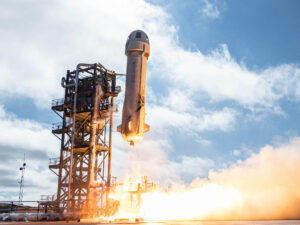Space News: Blue Origin to simulate lunar gravity on suborbital flights for NASA

WASHINGTON — NASA has signed an agreement with Blue Origin to use that company’s New Shepard suborbital vehicle for flights that will simulate the reduced gravity on the surface of the moon.
NASA said March 9 that it is supporting upgrades to New Shepard to allow the vehicle to briefly similar lunar gravity on its suborbital flights. On those flights, the vehicle’s crew capsule will use reaction control thrusters to spin at a rate of 11 revolutions per minute, turning it into a centrifuge that can simulate lunar gravity — approximately one-sixth of Earth’s gravity — for more than two minutes.
While NASA can perform extensive testing in microgravity on the International Space Station, and for shorter periods on suborbital vehicles and aircraft flying parabolic trajectories, it is far more difficult to perform tests in reduced gravity. Aircraft can simulate lunar gravity using versions of the same parabolic arcs flown for microgravity, but typically for no more than half a minute at a time.
“One of the constant challenges with living and working in space is reduced gravity,” Christopher Baker, program executive of NASA’s Flight Opportunities technology demonstration program, said in an agency statement. “A wide range of tools we need for the moon and Mars could benefit from testing in partial gravity, including technologies for in situ resource utilization, regolith mining, and environmental control and life support systems.”
Blue Origin has previously discussed using New Shepard for reduced gravity flights, such as simulating lunar gravity. At a webinar in August, Erika Wagner, director of payloads at Blue Origin, said the company was studying options for lunar gravity flights. At the time Blue Origin was planning the first such flight in “2022-ish.”
NASA said in its announcement the first lunar gravity New Shepard flight will be in late 2022. The agency took credit for enabling such flights through “development funding and early purchase of payload space by NASA as part of its strategic investment in the U.S. spaceflight industry.”
NASA spokesperson Clare Skelly told SpaceNews that NASA purchased about half the payload space on a lunar gravity flight and supported development of the capability as part of a contract task valued at $2.69 million. She said the pricing of individual items on that task is “competition sensitive” and thus not published.
Blue Origin is one of several companies that provide services to NASA’s Flight Opportunities program through suborbital vehicles, high altitude balloons and parabolic aircraft flights. Those flights are intended to demonstrate technologies at high altitudes or in reduced gravity not otherwise possible short of going into orbit. Flight Opportunities received $27 million in fiscal year 2021, with $7 million set aside to support development and flight of educational payloads.
from SpaceNews https://ift.tt/2PLVh8F